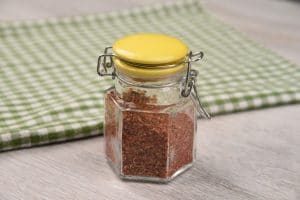How Long Does Homemade Yogurt Last?
Important Note: When you buy through our links, we may earn a commission. As an Amazon Associate we earn from qualifying purchases. Content, pricing, offers and availability are subject to change at any time - more info.
Yogurt has played a significant role in the human diet for centuries. Making your own is not only satisfying; it is better for the environment, saves money, and gives you greater control of what goes in your body. Plus, you have the comfort of knowing your probiotics are alive. But do you have to make it every day, or does it keep in the fridge for a while?
Homemade yogurt lasts for a week in the fridge and sometimes for up to two weeks. To ensure your culture will make new yogurt, you should make a new batch of yogurt at least once a week. You can freeze or dry your culture if you want to take a break from making yogurt.
Life isn’t always predictable. One week you’ll have a full household, and you’re making yogurt every other day to keep up with demand. Next thing you know, you’ve got an entire batch ready to go and only you in the house. Nobody likes wasting food, but getting food poisoning is unpleasant. So, it is also essential to know the signs of yogurt that’s gone bad.
- How Long Does Homemade Yogurt Last?
- How Long Can You Store Yogurt Cultures?
- How Do I Tell If My Homemade Dairy Yogurt Has Gone Bad?
- How Do I Tell If My Homemade Dairy Yogurt Has Gone Bad?
- What Happens If I Eat Yogurt That Has Gone Bad?
- How Long Can You Ferment Homemade Yogurt?
- So, How Long Does Homemade Yogurt Last?
How Long Does Homemade Yogurt Last?

Homemade dairy yogurt can last between one to two weeks in the fridge. However, the freshness of the milk you used to make the yogurt will impact how long the yogurt stays good. Also, additives impact homemade yogurt’s lifespan. For example, homemade yogurt that contains fresh fruit will go bad in a week or less.
Vegan yogurts often go off earlier, and the signs of going made may differ from dairy yogurts. For example, coconut milk yogurts separate easily, even while you make it. But they can last 5-10 days in the fridge. Homemade nut yogurts, such as cashew, last in the fridge for 4-6 days.
If using some of your homemade yogurt as the starter for the next batch, you need to use with within a week. Refrigeration slows down the growth of the probiotics, and they can start to die off after a week slowly. Thus, to ensure they are happy and healthy, they need to be given a new home (and, more importantly, sugar) within seven days.
How Long Can You Store Yogurt Cultures?

Yogurt requires bacterial strains from either a culture or a starter. This is where yogurt obtains its probiotics. Some yogurts, such as Bulgarian, have particular bacterial strains. When you want to begin making your own yogurt, you either buy these specific cultures or use a scoop of yogurt, called “starter,” from the variety you wish, such as Bulgarian.
Some people add probiotics from their pill supplements. However, these are used in addition, not as a replacement of the bacterial strains required to make most yogurts. Exceptions do exist, however, including our potato milk yogurt recipes.
These bacteria cultures must be kept alive in order to continue making fresh, homemade yogurt without having to buy more cultures or store-bought yogurt. However, life can get hectic, and sometimes there isn’t time to keep making it every 4-6 days. You can take a break by freezing or drying your starter if this happens.
How Long Can You Rest A Yogurt Culture In A Freezer?
Freezing your yogurt starter is the easiest way to take a break from making yogurt. However, freezing is the shortest long-term storage option, as it must be used within four weeks. Nor is it foolproof. Cultures are not big on temperature changes, and they sometimes give up the will to live.
How To Freeze Your Yogurt Starter?
When you want to take a break, it is best to take your starter from freshly made yogurt, not stuff near the end of its week. This will give you the best chance of success. Remember: 1 Tbsp of starter is needed for every 1 cup of milk. This measurement is true for most non-dairy yogurts, too.
To freeze starter:
- Use a clean ice cube tray
- Measure out 1 Tbsp per block
- Once the starter is completely frozen, keep it in an airtight freezer container
When you are ready to reboot your yogurt making:
- Remove the required amount of starter from the freezer
- Place the frozen cubes in a clean airtight container
- Allow cubes to thaw gradually in the fridge
- Wait until fully thawed before making yogurt
Do note, the longer the starter has been in the freezer, the less oomph it will have. If your starter has been resting for three weeks or longer, consider using double the amount of starter for your next batch of yogurt.
Once you have successfully made a fresh batch of yogurt, you can use the usual amount of starter from that batch to make the batch after that.
Can Frozen Yogurt Cultures Go Bad?
Frozen yogurt cultures do not typically spoil. Typically, the starter simply won’t work, and your attempt at making yogurt with them will fail. They generally won’t spoil unless contaminated in some manner. However, if the thawed cubes smell odd or have had a change of color, then you should be suspicious.
Can You Refreeze A Yogurt Starter?
It is not advised to refreeze a yogurt culture. This is both harmful to the good bacteria and can introduce new bacteria that might make you ill.
How Long Can You Rest A Dried Yogurt Culture?
Drying your starter will allow you the longest break as it can last two to three months if kept in ideal conditions.
To dry starter:
- Take 2 Tbsp of starter and spread it out on unbleached parchment paper
- Find a warm spot not hotter than 80F for the yogurt to dry
- Once dried, store in a sealable freezer bag and place in the fridge
Once you are ready to use it, be sure to use it as you would any powdered activator, keeping the yogurt at the proper temperature while it sets.
Can Dried Yogurt Culture Go Bad?
Dried yogurt starters do not tend to go bad as much as they simply don’t work. However, they should be tossed out if they smell funny or show signs of discoloration or something growing on them. This typically only occurs if they are contaminated in some manner.
How Do I Tell If My Homemade Dairy Yogurt Has Gone Bad?
We all know probiotics with the “good bacteria” are excellent for our health. But not all bacteria are beneficial. If homemade yogurt turns into the breeding ground for the wrong stuff, it isn’t good to eat it. Thus, it is important to know the signs of when dairy yogurt has gone off.
Odor
Be aware of the way your yogurt smells. It will begin to remind you of milk that is going off. It isn’t a big deal if you don’t catch it, as your yogurt will still be safe to eat. But it is an early warning. However, it is time to toss your yogurt out if it has become truly foul, like rancid milk.
Texture
Examine the texture of your yogurt. It should be uniform in its gelatin-like state: smooth and creamy. A little whey at the top isn’t a worry, so long as it doesn’t smell.
However, yogurt that’s going off begins to resemble cottage cheese, with lumps and clumps. In addition, there will probably be a watery ooze on the surface that doesn’t seem right.
Color
Edible yogurt will look as it did. But if the liquid onto the top has started to yellow or go brown, that’s a sign it is going off. Mold can be white, so it can be challenging to detect, but it can change the shade of your yogurt, making the coloration inconsistent. Some mold is dark, and then it is obviously inedible.
How Do I Tell If My Homemade Dairy Yogurt Has Gone Bad?
Vegan yogurts all smell and look a bit different. One common issue, however, is that they separate. However, separation should not create mold spots; those are spoilage. Nor should separation change the texture after it is mixed. If you are stirring the yogurt and the texture is still off, then it means the yogurt is going bad.
When it comes to smell, it doesn’t necessarily smell awful, simply different. Oatmeal yogurt, for example, will begin producing a more acidic odor that gets worse as it continues to spoil. Also, when vegan yogurt begins to spoil, the sourness will deepen. However, some vegan yogurts don’t taste sour, so if they develop a sour taste, you should stop eating them.
What Happens If I Eat Yogurt That Has Gone Bad?
There is a persistent myth that eating yogurt that has gone off is just yogurt that’s fermented longer. Bacteria come in many forms and can get into food in numerous ways. When a new bacteria has been introduced into the food, it can begin to crowd out the other bacteria. These new bacteria that cause the yogurt to go off are not beneficial to our bodies.
Also, yogurts with added ingredients, such as fruit, will easily grow bacteria that we don’t want. These yogurts spoil faster than plain yogurts. This is partly due to the sugar they contain.
Yogurt that has only slightly gone off will rarely do much to a healthy person with no immune or chronic health issues. However, the more “off” the yogurt is, the more concentrated the bad bacteria, and thus the greater impact it will have on the body. Eventually, it becomes food poisoning.
The degree to which a person is impacted by food poisoning depends on the person and how spoiled the food is. Also, food poisoning from vegan yogurts tends to have much more mild symptoms than those from bad dairy yogurts. Nonetheless, it is best not to eat any type of yogurt that has gone off.
Common adverse reactions from eating spoiled yogurt include:
- Acid reflux
- Bloating
- Burping
- Diarrhea
- Flatulence
- Intestinal gas
- Stomach pain
- Vomiting
How Long Can You Ferment Homemade Yogurt?
Some yogurt recipes coagulate in three hours. Many recipes take up to 9-hours, however. But there are some that will ferment for 24-hours. However, after that, you begin to risk your good bacteria from running out of lactose in dairy yogurt or sugar if making vegan. Once the good bacteria runs out of sugar, your yogurt will start to spoil, becoming acidic and curdled.

As your yogurt curdles and spoils, the probiotics die off. Thus, you lose the good bacteria you want and make room for harmful bacteria to flourish. In the end, the yogurt can lead to food poisoning if consumed.
Will Longer Fermentation Make My Yogurt Lactose-Free?
While longer fermentation produces a thicker yogurt with less lactose, it is not lactose-free. There will be some lactose remaining, just not enough to keep all the good bacteria alive should you ferment it longer. For some, this is enough of a reduction in lactose for them to eat it. But it won’t be enough for everyone.
You can reduce lactose further by draining and straining your freshly fermented yogurt. This is how Greek yogurt is traditionally made. However, not all store brands do this. Some Greek-style yogurts use thickeners to achieve that extra creamy taste, which doesn’t reduce lactose. Also, some traces of lactose might remain even with draining and straining.
There are some lactose-free yogurt recipes out there for people who are struggling. These are not necessarily vegan. There are homemade yogurt recipes using lactose milk. Some starter cultures will eat the synthetic enzyme in commercial lactose-free milk and will not require sugar to be added to the recipe.
Will My Yogurt Lactose-Free Homemade Milk Last Longer?
While lactose-free milk lasts longer than regular milk, the difference in shelf life in yogurt is negligible. You might get a day or two more out of it before it starts to smell, but that’s provided you have not added anything else to it, such as fruit. But yogurt is already very low in lactose, so a lactose-free one offers minimal storing benefits.
So, How Long Does Homemade Yogurt Last?
When storing homemade yogurt, just remember how long you can eat it is different from how long it will be a viable starter for your next batch. The fresher the yogurt, the more success your starter will have. However, the actual yogurt can be eaten past when it can act as a starter. Just check its odor, texture, color, and taste for spoilage.
























